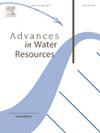含盐含水层微裂缝CO2扩散泄漏封存的微流控研究
IF 4.2
2区 环境科学与生态学
Q1 WATER RESOURCES
引用次数: 0
摘要
通过固有或诱导盖层裂缝的CO2扩散泄漏或扩散输送对含盐含水层CO2封存的安全性造成了重大影响。尽管这一问题引起了相当大的兴趣,并已成为许多数值分析的主题,但实验研究仍然有限。本文首次对广义微流控系统中CO2通过微裂缝扩散泄漏进行了实验研究,该系统代表了该系统在现实CO2封存条件下的关键特征。我们的研究结果揭示了多孔介质中被困二氧化碳的两阶段耗竭动力学,由溶解和通过裂缝的扩散驱动。第一阶段的特征是CO2迅速溶解到附近的盐水中,而第二阶段的特征是CO2在溶解度极限的驱动下通过裂缝扩散到水汇中,泄漏速率稳定,假设微裂缝结构稳定,平流可以忽略不计。在这两个阶段之间,有一个过渡时期,在此期间CO2饱和度保持稳定。提出了量化扩散泄漏过程的两个关键参数:过渡时间和稳态泄漏率。过渡时间0.1l2D定义了扩散泄漏事件发生的时间尺度,其中l表示裂缝长度,D表示气体扩散系数。稳态泄漏率主要由含水层条件和裂缝性质决定,其尺度为DC1l,其中C1为溶解度极限。我们的理论预测与实验结果很吻合。此外,通过敏感性分析探讨了温度、压力、盐度和储存深度对CO2扩散系数和溶解度的影响。尽管我们的实验设计和建模简化了,但我们的研究通过逐步纳入更多的复杂性为未来的研究奠定了基础。这些发现为评估地下地质储气库(如H2和CH4)的泄漏风险提供了更广泛的意义。本文章由计算机程序翻译,如有差异,请以英文原文为准。
Microfluidic study of CO2 diffusive leakage through microfractures in saline aquifers for CO2 sequestration
CO2 diffusive leakage, or diffusive transport, through intrinsic or induced caprock fractures poses a significant concern for the security of CO2 sequestration in saline aquifers. Although this issue has garnered considerable interest and has been the subject of many numerical analyses, experimental studies remain limited. We present the first experimental investigation of CO2 diffusive leakage through microfractures in a generalized microfluidic system that represents the key features of the system under realistic CO2 sequestration conditions. Our findings reveal two-stage depletion kinetics of trapped CO2 in porous media, driven by dissolution and diffusion through fractures. The first stage is characterized by the rapid dissolution of CO2 into nearby brine, while the second stage exhibits a steady leakage rate as CO2 diffuses through the fractures into a water sink, driven by the solubility limit, assuming stable microfracture structures and negligible advection. Between these two stages, there is a transition period during which CO2 saturation remains stable. Two key parameters are proposed to quantify the diffusive leakage process: the transition time and the steady-state leakage rate. The transition time defines the timescale for the onset of a diffusive leakage event, where l represents the fracture length and D the gas diffusivity. The steady-state leakage rate is primarily governed by aquifer conditions and fracture properties, which scales as , where C1 is the solubility limit. Our theoretical predictions align well with the experimental results. Additionally, the effects of temperature, pressure, salinity, and storage depth on CO2 diffusivity and solubility are explored through sensitivity analysis. Despite the simplifications in our experimental design and modeling, our study lays the foundation for future research by progressively incorporating additional complexities. These findings provide broader implications for assessing leakage risks in subsurface geological gas storage, such as H2 and CH4.
求助全文
通过发布文献求助,成功后即可免费获取论文全文。
去求助
来源期刊

Advances in Water Resources
环境科学-水资源
CiteScore
9.40
自引率
6.40%
发文量
171
审稿时长
36 days
期刊介绍:
Advances in Water Resources provides a forum for the presentation of fundamental scientific advances in the understanding of water resources systems. The scope of Advances in Water Resources includes any combination of theoretical, computational, and experimental approaches used to advance fundamental understanding of surface or subsurface water resources systems or the interaction of these systems with the atmosphere, geosphere, biosphere, and human societies. Manuscripts involving case studies that do not attempt to reach broader conclusions, research on engineering design, applied hydraulics, or water quality and treatment, as well as applications of existing knowledge that do not advance fundamental understanding of hydrological processes, are not appropriate for Advances in Water Resources.
Examples of appropriate topical areas that will be considered include the following:
• Surface and subsurface hydrology
• Hydrometeorology
• Environmental fluid dynamics
• Ecohydrology and ecohydrodynamics
• Multiphase transport phenomena in porous media
• Fluid flow and species transport and reaction processes
 求助内容:
求助内容: 应助结果提醒方式:
应助结果提醒方式:


